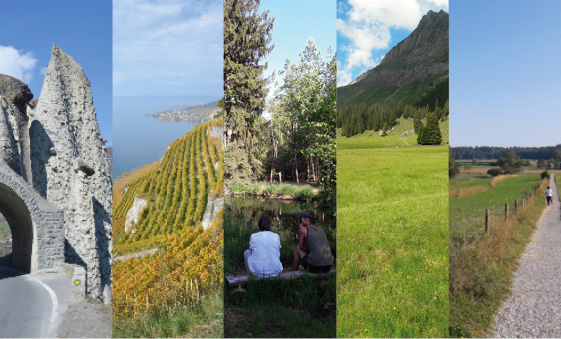Navigation auf uzh.ch
Navigation auf uzh.ch
The impact of landscapes on human well-being is manifold: We appreciate the beauty, we feel we belong there, we can relax and promote our health. In five landscapes of national importance in Switzerland, researchers from the universities of Zurich and Lausanne assessed how landscape services are perceived and derived concrete recommendations for action.

Landscapes provide us with direct economic, social and health benefits: We appreciate their beauty, we identify with them, we can relax and promote our health. And finally, landscapes make a location attractive and constitute the spatial foundation for biodiversity.
On behalf of the Swiss Federal Office for the Environment (BAFU), researchers from the universities of Zurich and Lausanne assessed the perceived landscape services in five pilot regions of Switzerland. They conducted interviews with experts from public authorities, agriculture, tourism, and nature conservation. One of these pilot regions is the area of Chatzenseen. This nature oasis on the outskirts of Zurich is an important local recreation area with hiking and cycling trails and a freely accessible swimming facility. The utilization pressure and the number of visitors is high, particularly on summer days. Many of the interviewees considered the balance between protection and use as a constant tightrope walk. In order to preserve or even strengthen the typical features of this landscape, many expressed a need for information and for awareness-raising about the special qualities of this landscape.
"Based on these findings, we can now derive concrete recommendations for action", says Roger Keller, one of the authors of the study. For example, how communication and the dialogue with the population can be improved, how the various stakeholders can cooperate better and which contributions can be provided by the public authorities.
|
The term "landscape services" refers to non-material functions of the landscape, as opposed to material functions such as provision of food or water purification. Landscape services focus on aesthetic appreciation, recreation and health, possibilities for identification and sense of place as well as attractiveness of the location and biodiversity. |
Landschaftsleistungen in Landschaften von nationaler Bedeutung
Forschungsbericht mit Handlungsempfehlungen für Bund, Kantone, Gemeinden, NGOs und Bewirtschaftende
Prestations paysagères dans les paysages d’importance nationale
Rapport de recherche et recommandations à l’intention de la Confédération, des cantons, communes, ONG et acteurs économiques
Roger Keller, Mélanie Clivaz, Norman Backhaus, Emmanuel Reynard
available in German and French only
Keller, R.; Clivaz, M.; Reynard, E.; Backhaus, N. Increasing Landscape Appreciation through the Landscape Services Approach. A Case Study from Switzerland. Sustainability 2019, 11, 5826.